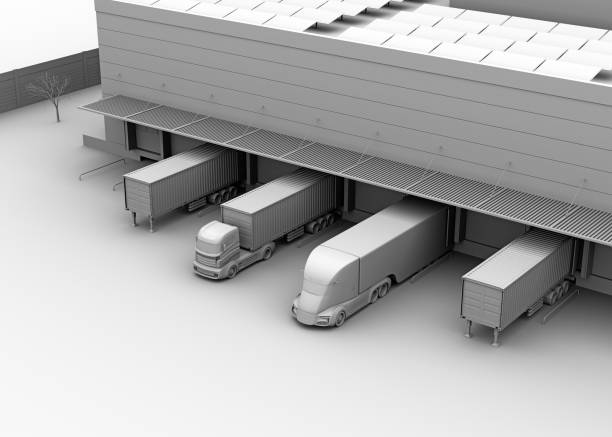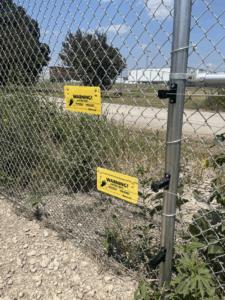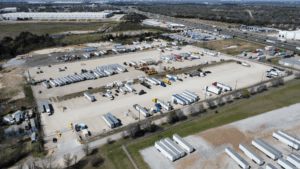Navigating truck parking can be tricky without knowing the necessary space dimensions. This guide, “Understanding Truck Parking Dimensions: A Complete Guide to Parking Space Sizes,” provides essential information on the required sizes for different types of trucks. We’ll break down standard parking space dimensions, explain how they fit various trucks, and why getting this right matters for safety and regulation compliance. From tight urban spots to secure overnight parking, knowing these details helps drivers and fleet managers make informed decisions. With insights into facilities like Dallas Truck Parking, this article ensures you know how to choose the best parking spots confidently.
The Basics of Truck Parking Dimensions
Understanding truck parking dimensions is essential for ensuring that large vehicles can be accommodated safely and efficiently in designated parking spots. These dimensions are crucial not just for fitting the truck into a parking space but also for ensuring there is enough room for maneuvering and for drivers to access facilities without obstacles.
Truck parking spaces are typically much larger than those for cars because trucks are bigger in both length and width. The standard parking space for a commercial truck in the United States varies but generally starts at about 12 feet wide and can extend up to 15 feet wide, depending on the facility and the type of truck it accommodates. The length of these parking spots also varies significantly. While a typical car parking space might be around 18 to 20 feet long, truck spaces can range from 30 to 40 feet long to accommodate the extended length of semi-trucks and trailers.
Moreover, when planning the size of a truck parking lot, it is important to consider the turning radius of a truck. This ensures trucks can enter and exit the spaces safely without risk of damage to the vehicle or the parking infrastructure. Adequate clearance around the parking spots is also necessary to provide space for the trucks to maneuver while parking and leaving.
For truck drivers, knowing these dimensions is crucial for selecting suitable parking locations, especially when hauling large loads or navigating through areas with limited parking options. Facilities like Dallas Truck Parking ensure that their dimensions meet these standards, providing a safe and accessible environment for truck drivers to rest and refresh.
In conclusion, the basics of truck parking dimensions are key to the successful design and utilization of truck parking facilities. By adhering to these guidelines, parking areas can serve the needs of large vehicles efficiently, ensuring safety and convenience for all users.
Related: Parking for Semi Trucks Near Me: Trusted Options for 24/7 Access and Safety
Standard Parking Space Dimensions
Knowing the standard dimensions for truck parking spaces is crucial for drivers to ensure their vehicles fit properly without risk of damage or fines for improper parking. Here’s a breakdown of the typical sizes you’ll find in truck parking lots across America, like those at Dallas Truck Parking.
For most semi-trucks, a standard parking space is significantly wider and longer than what you’d find in a typical car parking lot. Generally, the width of a truck parking space ranges from 12 feet to 15 feet. This extra width accommodates the truck’s larger size and provides some space for the drivers to open doors and load or unload goods without hindrances.
The length of truck parking spaces is another critical dimension. While passenger vehicle spots might average 18 to 20 feet in length, truck spaces typically start at about 30 feet and can go up to 40 feet or more, depending on the type of the truck and trailer. This length is necessary to fit the entire truck, from bumper to bumper, including any cargo elements like a sleeper cab.
It’s also essential to consider the vertical clearance in parking facilities, which should be high enough to accommodate tall trucks. The standard height clearance should be at least 14 feet to prevent damage to both the vehicle and the parking structure.
Understanding these dimensions is vital not just for parking but also for navigating through parking lots without accidents. Facilities like Dallas Truck Parking are designed with these standards in mind, ensuring that every space is sized appropriately for commercial trucks, providing a safe and convenient stopping point for drivers. With proper parking space dimensions, truck drivers can rest easy knowing their vehicles are safely accommodated.
Comparing Parking Space Sizes
The dimensions of parking spaces can vary significantly between those intended for passenger vehicles and those designed for trucks. Understanding these differences is key for truck drivers planning where to stop and rest. Here’s a look at how truck parking dimensions stack up against standard car parking sizes.
Standard car parking spaces typically measure about 9 feet wide and 18 feet long. These dimensions provide enough room for most passenger vehicles, including sedans, hatchbacks, and even some smaller SUVs, allowing for comfortable access and minimal risk of dings or scratches from adjacent cars.
In contrast, truck parking spaces are much larger. The typical width of a truck parking spot ranges from 12 to 15 feet, accommodating the wider bodies of commercial vehicles. The length of truck parking spaces is even more generous, starting at 30 feet and extending up to 40 feet or more, necessary to fit the entire length of the truck and its trailer. This size also helps in maneuvering the truck in and out of the space without risk of hitting other parked vehicles or infrastructure.
Furthermore, the height clearance in truck parking areas is another critical difference. While car parks rarely specify height restrictions, truck parking areas must have a minimum clearance of about 14 feet to accommodate the taller stature of trucks, especially those with cargo stacked high.
Understanding these differences is crucial not only for finding the right place to park but also for ensuring the safety and legality of parking. Places like Dallas Truck Parking cater specifically to the needs of truck drivers, offering spaces that meet these dimensions, thereby ensuring that trucks are parked safely and securely.
Related: Struggling to Parallel Park Your V8 Long Bed Truck? Here’s How to Nail It Every Time
Key Factors Influencing Truck Parking Space Design
Designing a truck parking space isn’t just about marking out a large rectangle on the pavement. Several key factors must be considered to ensure these spaces are safe, accessible, and efficient for heavy vehicles. Understanding these factors can help truck stop planners and drivers appreciate the complexity behind the areas where trucks rest.
- Vehicle Size and Type: The primary consideration in truck parking design is the size and type of vehicles that will use the space. Different trucks, from box trucks to semi-trailers, have varying dimensions and turning requirements, which influence the size and layout of the parking spots.
- Maneuverability: Adequate space must be provided not just for parking but also for trucks to enter and exit spots easily. This involves designing wider lane widths and appropriate angles of parking to accommodate the turning radius of large trucks.
- Traffic Flow: Efficient traffic flow within the parking area is crucial to prevent congestion and accidents. This includes one-way traffic patterns, clear signage, and enough entry and exit points to handle the volume of trucks expected.
- Safety Features: Safety is paramount in truck parking design. This includes installing bright lighting, surveillance cameras, and emergency stations. Proper lighting not only enhances security but also aids drivers in parking safely during nighttime.
- Accessibility: Truck parking spaces must be accessible to all drivers, including those with disabilities. This involves compliance with legal standards for accessibility in terms of space dimensions and the placement of pedestrian pathways.
- Environmental Considerations: Modern truck parking designs also consider environmental impacts. This could involve using permeable materials for surfacing to reduce runoff, landscaping to control heat, and providing facilities for waste disposal to keep the area clean.
- Services and Amenities: Finally, the best truck parking designs incorporate services that drivers need. This can include fuel stations, restrooms, showers, and food outlets. Having these amenities close to parking spots makes it a restful and rejuvenating stop for drivers.
How to Measure Truck Parking Spaces
Measuring truck parking spaces accurately is essential for the design and use of any truck parking facility. Proper measurements ensure that spaces are safe and accessible for large vehicles. Here’s a straightforward guide on how to measure truck parking spaces effectively.
Step 1: Determine the Type of Trucks
Before you start measuring, identify the types of trucks that will use the parking spaces. Different trucks have different dimensions and turning requirements. Knowing the types of trucks helps in defining the minimum size needed for each space.
Step 2: Measure the Width and Length
Use a long measuring tape to measure the width and length of the parking space. For standard semi-trucks, the width should be at least 12 feet. The length should accommodate the truck and its trailer, typically ranging from 30 to 40 feet. Ensure you measure in a few different places to account for any irregularities in the surface or layout.
Step 3: Check Clearance and Turning Radius
It’s crucial to measure the clearance around the parking spaces. There should be enough room for trucks to maneuver safely into and out of the spaces without risk of damage. Also, measure the turning radius required based on the types of trucks using the facility.
Step 4: Marking and Documentation
Once measurements are taken, mark the boundaries clearly with paint or permanent markers. Document these measurements along with any specific features or limitations of each space.
Related: The Best Semi Truck and Trailer Parking in DFW: Locations, Amenities, and Rates
Navigating Large Parking Lots: Tips for Truck Drivers
Handling a semi-truck in a large parking lot can be a challenging task, especially when it’s crowded and space is tight. Here are some practical tips for truck drivers to navigate large parking lots safely and efficiently.
- Plan Your Entry and Exit: Before entering a large parking lot, it’s wise to have a clear plan. Know the entry and exit points and the easiest route to your designated parking spot. This planning helps avoid unnecessary maneuvering and reduces the risk of accidents.
- Use Appropriate Speed: Always maintain a low speed within parking lots. This gives you more time to react to unexpected obstacles or movements from other vehicles and pedestrians.
- Wide Turns: Given the size of a semi-truck, making wider turns is necessary to prevent clipping other vehicles or infrastructure. Be aware of your truck’s turning radius and give yourself plenty of room to turn safely.
- Monitor Blind Spots: Large trucks have significant blind spots. Use your mirrors effectively and consider installing additional blind-spot mirrors or cameras to improve visibility around your truck.
- Look for Properly Sized Spaces: Only park in spaces designed for trucks, which should match the truck parking dimensions you know are safe. Parking in a space that’s too small can lead to difficult and unsafe situations when trying to leave.
- Communicate with Other Drivers: If maneuvering in tight spots, don’t hesitate to communicate with other drivers. Use hand signals or your horn to indicate your intentions clearly.
- Use Technology: Modern technology like GPS and parking apps can provide real-time information about available parking spaces and any restrictions that may apply, especially in unfamiliar areas.
Related: 18-Wheeler Truck Parking: Affordable and Accessible Lots for Long-Haul Drivers






